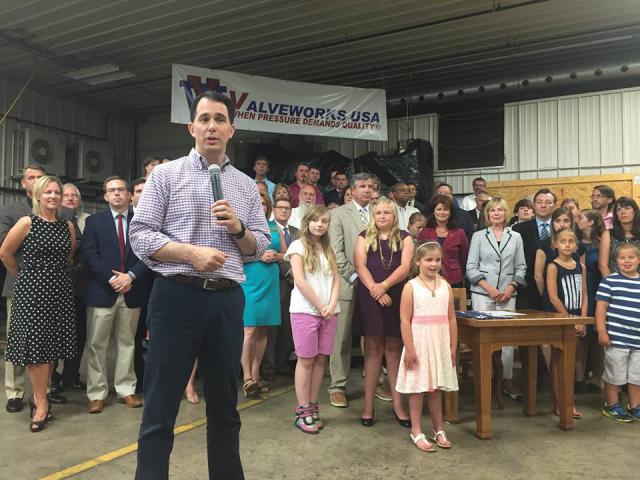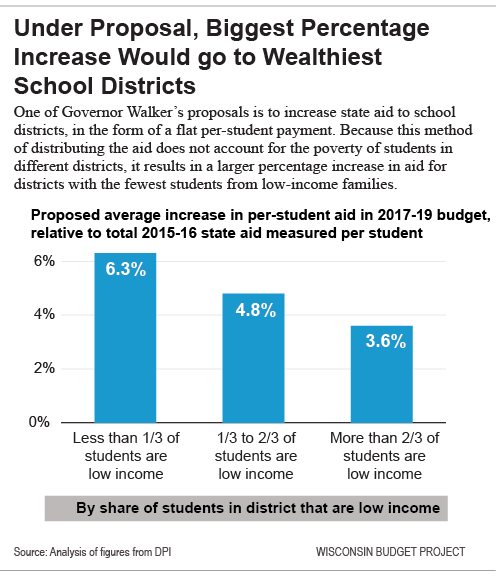Budget Boost Helps Wealthiest Schools
New funding in Walker budget targets school districts least in need.

Governor Scott Walker signs the 2015-17 State Budget into law at Valveworks USA in Waukesha. Photo from the State of Wisconsin.
Governor Walker has proposed significantly increasing state support for public schools, but the bulk of the increase would be distributed to school districts in a way that does not take into account the challenges faced by districts with high numbers of students coming from families with low incomes.
We don’t yet have the full details on what the Governor is proposing for the state’s education budget, but he released a brief summary earlier this week. His budget proposal includes additional funding at aimed addressing the challenges of rural schools, increasing student achievement in summer school programs in Milwaukee, and helping school districts connect students with disabilities to employment. (Read more about his education proposals in this AP article: Walker Proposes Big $649 Million Boost for K-12 Schools.)
That increase represents a major investment in Wisconsin’s schools, with the state investing an additional $509 million in public schools over two years.
The problem with the new resources is the way they are delivered. Districts that serve mostly low-income students often need additional resources to help students achieve their full potential, compared to school districts in wealthy areas. But under the Governor’s proposal, each school district would get the same amount of increased aid per student, regardless of whether the district serves mostly students from families with low incomes or students from wealthy families. This approach doesn’t target aid to the schools with the highest costs or with students that are struggling to succeed academically, and it moves Wisconsin away from its long commitment to provide more assistance to districts with less capacity to boost local property tax support for schools.
School districts with the smallest share of students from families with low incomes would get the largest increase in funding under the Governor’s proposal, when the increase is measured in percentage terms. School districts in which less than one third of the students are low income would receive an average increase of 6.3% in funding over the course of the budget from the proposed increase in flat per-student funding, compared to the total amount of state aid that the district received in 2015-16 calculated on a per-student basis and doubled. School districts in which between one third and two thirds of the students come from low income families would receive an average increase of 4.8%. And school districts in which more than two-thirds of the students are low income would receive a bump of just 3.6% on average. (Students who come from families with incomes of less than 185% of the federal poverty guidelines are considered to be low income.)
Wisconsin State Superintendent Tony Evers has praised some components of the proposal, but cautioned the Governor about providing an increase in state aid on a flat per-student basis, saying “If you’re giving a wealthy district the same amount as a poorer district … over time that takes a toll.” (Read more about the reactions to the Governor’s proposal in this Milwaukee Journal Sentinel article: Gov. Scott Walker’s Budget Would Shift Wisconsin’s Approach to School Funding.)
If Wisconsin public schools are to continue to provide children with the kind of high-quality education that state residents have come to expect, then Wisconsin needs to make a major investment of the size that Governor Walker is recommending. But in order to make sure that all K-12 students have a chance to succeed, we should target that investment to help the students with the greatest need, and the districts with the least capacity to increase local tax levies.
Wisconsin Budget
-
Charting The Racial Disparities In State’s Prisons
 Nov 28th, 2021 by Tamarine Cornelius
Nov 28th, 2021 by Tamarine Cornelius
-
State’s $1 Billion Tax Cut Leaves Out 49% of Taxpayers
 Sep 21st, 2021 by Tamarine Cornelius
Sep 21st, 2021 by Tamarine Cornelius
-
TANF Program Serves a Fraction of Poor Families
 Aug 30th, 2021 by Jon Peacock
Aug 30th, 2021 by Jon Peacock


















